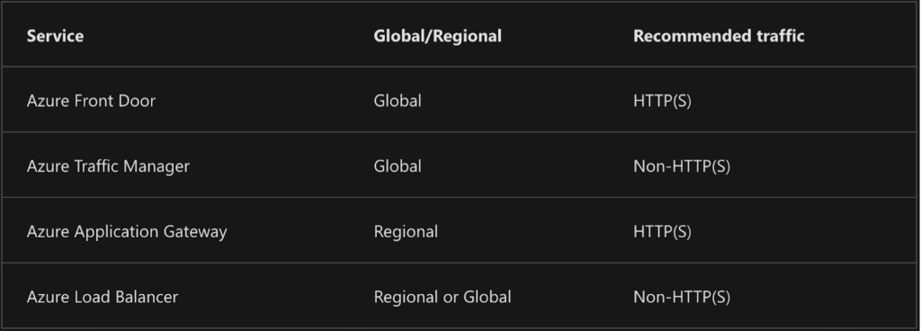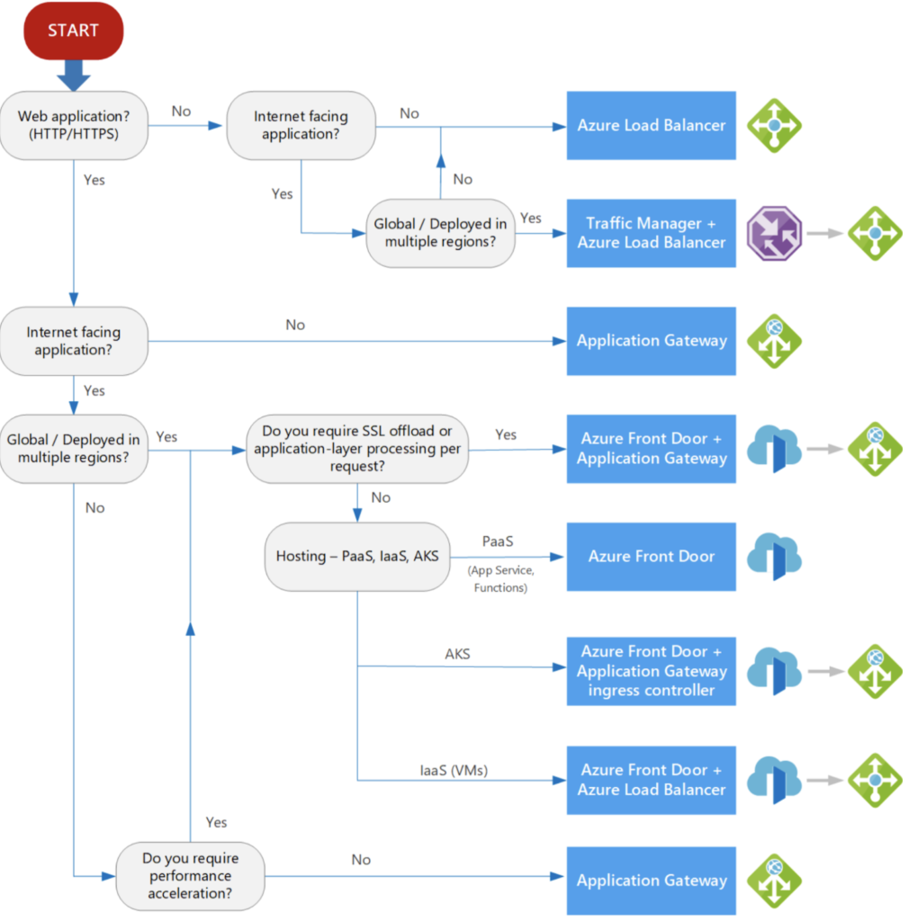Achieving Business Resilience with Effective Load Balancing in Azure
In today’s digital era, even brief downtime can cause significant financial and reputational damage, making business resilience is of top priority.
We’ll explore how Azure’s load balancing solutions can enhance business resilience and ensure continuous service.
Understanding Business Resilience
Business resilience refers to the ability of an organization to quickly adapt and recover from disruptions, maintaining continuous business operations. In IT infrastructure, it involves:
- High Availability: Ensuring that services are accessible without interruption.
- Fault Tolerance: Ability to continue operating even if part of the system fails.
- Scalability: Ability to handle varying loads without affecting performance.
- Disaster Recovery (DR) : Quickly restoring services after an unexpected outage.
Effective load balancing helps in achieving these objectives by distributing traffic, managing failovers, and optimizing resource utilization.
The Role of Load Balancing in Business Resilience
Load balancing distributes incoming network traffic across multiple servers to prevent any single server from becoming overwhelmed. This enhances business resilience in the following ways:
- Preventing Overload and Failures:
Load balancers evenly distribute traffic to avoid server bottlenecks and reduce overload risks. If a server fails, traffic is rerouted to healthy servers, ensuring continuous service availability. - Ensuring High Availability:
Load balancers monitor server health and redirect traffic to healthy servers if any fail, ensuring uninterrupted service. - Enhancing Performance:
Load balancing distributes traffic based on server capacity and current load, optimizing resource use for faster response times and a better user experience. - Facilitating Scalability:
Load balancing allows easy integration of additional servers to handle increased traffic, maintaining performance during peak loads. - Simplifying DR:
Load balancing quickly redirects traffic to backup servers or data centers during outages, minimizing downtime and speeding up recovery.
Azure Load Balancing Solutions
Azure provides various load-balancing solutions, each tailored to specific needs and contributing to business resilience. To select the right solution, first consider your application’s requirements by asking:
- Type of traffic: HTTP(S), TCP/UDP?
- High availability or scalability needed?
- Scope: Global or regional?
- Budget constraints and technical expertise.
Here’s a breakdown of key Azure services for building a robust architecture:
Azure Load Balancer (ALB):
- Use Case :
- High-throughput, low-latency layer 4 traffic distribution within the region as well as globally.
- Internal applications need load balancing within a private network.
- Scenarios requiring automatic failover.
- Features:
- Distributes inbound and outbound traffic,
- Supports multiple frontends, and
- Includes health probes for service monitoring.
- Resilience Benefit:
Ensures network traffic is evenly distributed and rerouted in case of failures, maintaining high availability.- High Availability: ALB offers active-passive deployments or zone redundancy within a region. This minimizes downtime during regional outages.
- Scalability: ALB can automatically scale up resources to handle unexpected traffic spikes, preventing service disruptions during peak load.
Azure Application Gateway (AAG):
- Use Case:
- Layer 7 traffic management with advanced routing, session management and security features within region.
- Scenarios needing SSL offloading and centralized certificate management.
- Applications needing protection against web attacks.
- Features:
- SSL termination,
- Web application firewall (WAF),
- URL-based routing,
- Session affinity.
- Resilience Benefit:
Protects web applications from common threats while ensuring efficient traffic routing and continuous availability.- High Availability: Similar to ALB, AAG can be configured for active-passive deployments or zone redundancy within a region,ensuring service continuity if a single instance or regional outage occurs.
- Web Application Firewall (WAF): AAG provides built-in WAF protection against common web attacks, safeguarding your applications from security breaches.
Azure Traffic Manager (ATM):
- Use Case:
- DNS-based traffic routing for globally distributed applications.
- Scenarios requiring global user base traffic management.
- Applications needing high availability and DR.
- Features:
- Multiple routing methods (priority, weighted, performance, geographic),
- Automatic failover,
- Endpoint monitoring.
- Resilience Benefit:
Directs traffic to the nearest or most responsive endpoints, ensuring global high availability and quick DR.- Global Failover: ATM routes traffic to the closest healthy regional endpoint. If a region becomes unavailable, traffic automatically fails over to the next healthy one, ensuring global service availability.
- Multi-Cloud Support: ATM can potentially route traffic to backend services hosted in other cloud providers/on-premises datacenters, offering redundancy beyond Azure.
Azure Front Door (AFD):
- Use Case:
- Provides global HTTP load balancing and content delivery to improve user experience and reduce latency.
- Scalable and secure delivery of web applications and APIs.
- Web applications needing global reach and performance optimization.
- Scenarios requiring seamless failover and DR.
- Features:
- Global load balancing,
- SSL offloading,
- WAF integration,
- Caching.
- Resilience Benefit:
Provides global load balancing and security features, ensuring high performance and protection against threats.- Seamless Failover and DR: During an outage event or disruption, it automatically redirects traffic to backup sites or alternate regions.
- DDoS Protection: Its built-in WAF feature safeguard applications from common threats and attacks, ensuring continuous operation and minimizing the risk of downtime due to security breaches.
We can refer to the below table (Ref: Azure Docs) based on the type of the traffic being served.

Choose LB based on Traffic type
Decision tree for load balancing in Azure( Ref Azure Doc)

Decision tree
Implementing Effective Load Balancing for Resilience
To maximize the resilience benefits of Azure load balancing solutions, consider the following best practices:
Regular Health Monitoring:
- Implement continuous health checks to monitor the status of your servers and services.
- Use Azure’s built-in health probes and monitoring tools to detect issues early and take corrective actions.
Automatic Failover and Redundancy:
- Configure load balancers to automatically reroute traffic in case of server failures.
- Ensure redundancy by deploying resources across multiple regions and availability zones.
Scalability Planning:
- Plan for scalability by configuring auto-scaling based on traffic patterns and demand.
- Use Azure’s scaling features to add or remove resources dynamically, maintaining optimal performance.
Security Integration:
- Enhance security by integrating load balancers with Azure’s security features such as WAF and DDoS protection.
- Regularly update and patch your infrastructure to protect against vulnerabilities.
Disaster Recovery Planning:
- Implement a robust disaster recovery plan that includes load balancing strategies.
- Test your failover and recovery processes regularly to ensure they work as expected during actual outages.
Business Case: Global E-Commerce Platform
Scenario:
A global e-commerce company is rapidly growing and needs to ensure its platform remains highly available, secure, and fast for users worldwide. With high traffic, especially during seasonal sales, it must deliver content quickly, handle traffic spikes, and maintain seamless operations during regional outages.
Business Requirements:
- Global Reach: Needs consistent performance worldwide.
- High Availability: Availability of 24/7 is a must with minimal downtime.
- Scalability: The platform must handle sudden traffic spikes during sales or promotions.
- Security: Needs Protection against DDoS attacks and other cyber threats.
- Performance: A fast and seamless user experience is essential for customer satisfaction.
- Disaster Recovery: Require a comprehensive plan to recover from regional/zonal failures.
Proposed Solution:
Based on the business requirements, a combination of Azure load balancing services can be implemented:
- Azure Traffic Manager (ATM): As the entry point, ATM will distribute traffic across different geographic regions based on user location, providing global load balancing, optimal latency, performance, and failover capabilities for disaster recovery. ATM offers various traffic routing methods, including geographic, weighted, and performance-based, which can be configured to prioritize healthy regions in case of failures.
Combining ATM with Azure Availability Zones and Azure Site Recovery creates a robust disaster recovery strategy, minimizing downtime and ensuring business continuity. - Azure Front Door (AFD): At each regional endpoint, AFD will act as a content delivery network (CDN), caching static content and accelerating website delivery, along with additional security features like WAF and built-in failover capabilities for disaster recovery.
- Azure Application Gateway (AAG): Within each region, AAG will handle advanced load balancing based on HTTP headers, cookies, or path-based routing, optimizing traffic distribution to backend services.
- Azure Load Balancer (ALB): ALB can be used for basic load balancing for internal traffic distribution and can serve as a fallback option within each region if AAG experiences an outage.
By combining these Azure load balancing services, the company can achieve:
- Global reach and performance: ATM and AFD optimize loading times worldwide.
- High availability: Multiple layers of redundancy, including Azure Traffic Manager’s failover capabilities and Azure Availability Zones, ensure minimal downtime.
- Scalability: Handles traffic spikes with ATM, AFD, and ALB.
- Enhanced security: AFD’s WAF and AAG’s features protect against threats.
- Disaster recovery: ATM’s geographic load balancing and Azure Site Recovery (for replicating infrastructure) provide a robust disaster recovery strategy.
Conclusion
Achieving business resilience is crucial in today’s digital landscape. Effective load balancing with Azure enhances IT infrastructure, boosts customer satisfaction, reduces costs, and strengthens competitive advantage.



